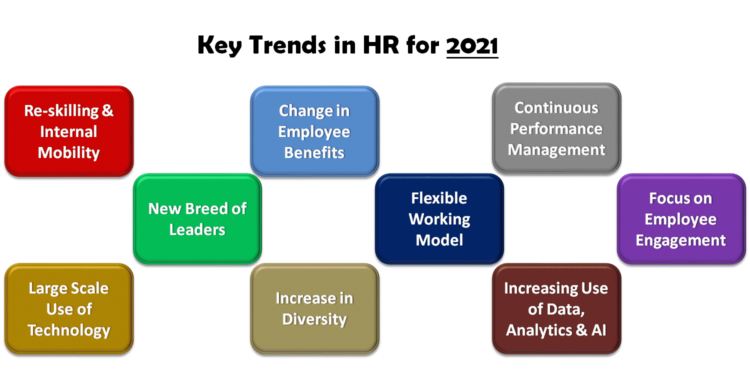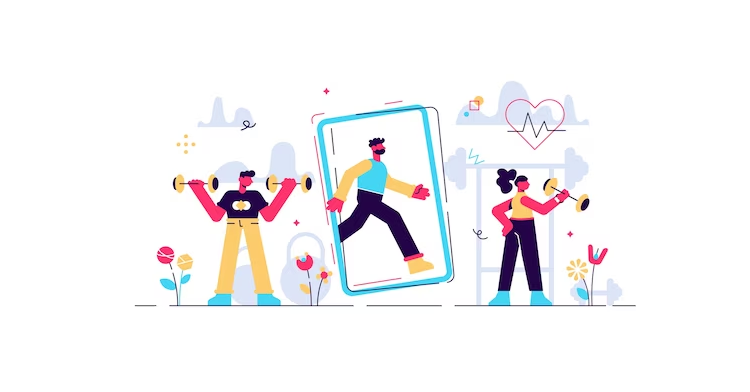1. Accelerated Digital Transformation: HR will see increased digitization across all functions, from hiring to performance management, driven by post-pandemic recovery and the need for efficiency and cost reduction.
2. Adoption of Flexible Working Models: Organizations will continue to embrace remote and flexible working arrangements, emphasizing output over time and location, and supporting the gig economy’s growth.
3. Focus on Reskilling and Internal Mobility: High competition for talent will push organizations to reskill existing employees and enhance internal mobility to fill skill gaps cost-effectively.
4. Increased Use of Data, Analytics, and AI: Leveraging data and AI will enable more intelligent decision-making in hiring, performance evaluation, employee engagement, and retention strategies, providing a competitive advantage.
Over the last two decades, HR has been changing due to the rapid transformation in the business environment and technology. We believe that the COVID-19 pandemic will accelerate the transformation of HR. Let’s take a look at the key trends in HR for 2021 and beyond:
Many organizations have lagged in adopting modern HR practices and technologies.
The Covid-19 pandemic and its aftermath hit them hard, forcing drastic changes overnight in the way they operate; the changes that they had been postponing for years!
We believe that two key factors will drive the changes in HR in 2021:

Post-COVID-19, we might see a sharp economic recovery in 2021. The pent-up consumer demand from 2020 might also help.
Hence, organizations will be firing on all cylinders to seize this opportunity to grow their businesses and recoup some of the losses from 2020.
Hence, this will result in increased HR activities on many fronts – hiring, performance management, employee engagement, learning and development, etc.
Read Long-term Impact of Corona Virus Pandemic on the Workplace

What happened due to the pandemic might become the new normal for many organizations as they realize the many benefits of having most of their employees working remotely regularly.
Hence, having tested the waters with the work-from-home model, many organizations are likely to tweak their operating models in 2021 to have only a minimal number of employees working from physical office locations.
It will help them significantly reduce their operating costs and make up some of the losses from 2020.
Read Post-COVID: ‘Digital Workplace’ is a must for all organizations
Let’s take a look at the key trends in HR for 2021 and beyond:
1. Large-scale Use of Technology
2. Flexible Working Model
3. Increase in Diversity
4. Reskilling and Internal Mobility
5. New Breed of Leaders
6. Continuous Performance Management
7. Focus on Employee Engagement
8. Changes in Employee Benefits
9. Increasing Use of Data, Analytics, and AI


What started in a big way in 2020 will get even more significant in 2021.
Organizations are likely to go full steam on the complete digitization of HR processes right from hiring and onboarding, to talent management, learning and development, performance management, and even employee exit.
So, in 2021, armed with fresh budgets and the prospect of higher business growth, organizations are likely to invest more in digital platforms for collaboration and communication, employee self-service, employee recognition, and learning management, to name a few.
‘Go digital’ will be the new mantra for HR!
Read about 7 Ways HR Software Can Support Your Remote Workers

Also, 2020 was the year of reckoning for organizations that had never tried the work-from-home or remote working models.
Organizations should have learned many lessons from the rude shock of the lockdown. Remote working or working from home will be the new workforce management strategy.

Organizations that had experimented with working remotely in a small way will now consider permanently relegating a much larger segment of their workforce to work-from-home status.
Other organizations might also consider the many employees who work from home regularly and step into an office only on a ‘need basis.’

In 2021, the working model will likely become more flexible than ever.
Work is likely to be increasingly defined by goals and tasks rather than time and location.
It should also boost the ‘gig economy’ with more part-timers, freelancers, and temporary project resources.

Also, organizations will likely hire more diverse talent in their workforce in 2021.
With the flexibility of time and location of work, we are likely to see students, new and returning mothers, differently-abled, etc. joining the workforce in larger numbers.
We will also see more talent getting hired from smaller places who will work remotely.
The ‘gig model’ will also open the doors for those seeking only part-time or remote employment for personal reasons.
Read the Guide for Ensuring Diversity and Inclusiveness at the Workplace

In 2021, high competition in the talent market will make it challenging to find candidates with the desired skills quickly.
In such a situation, reskilling existing members of the workforce can prove cost-effective to address the talent shortage.
Hence, reskilling will allow organizations to utilize and retain existing talent.
Hence, re-skilling will be high on the agenda of the learning and development leaders.

The leaders who have thrived in 2020 have grappled with unfamiliar crises.
They coordinated with their remote teams effectively and kept their team members motivated and productive.
Despite multiple challenges, they also effectively utilized various digital tools and platforms to meet customer expectations.
2021 is likely to see the rise and growth of this new breed of digital-first leaders to even higher levels.
Therefore, leadership development will focus more on developing the digital skills required for leading virtual teams in an increasingly digital workplace.
Read about 5 Effective Tips for Remote Management of Teams

The flux in the business environment and dynamic goals will push organizations towards shorter performance assessment cycles and even continuous performance management.
Hence, the widespread use of digital work tools in an integrated fashion will enable employee performance to be measured and assessed easily without too much manual effort.
‘Intelligent’ performance management systems will be able to provide first-level feedback to employees and highlight skill gaps and training needs.
Therefore, managers and supervisors should step in to provide a deeper level of feedback, mentoring, and coaching.
Read about Automated Performance Assessment – Rise of the Machines

A remote workforce must constantly feel engaged to prevent its gradual isolation from the organization.
Hence, in 2021 there will be a renewed focus on employee engagement, albeit through digital means. So, remote workers will need regular validation and appreciation from their supervisors and peers.
Hence, 2021 will see increasing use of digital employee rewards and recognition platforms to motivate the remote workforce, promote teamwork, build organizational culture, and drive commitment and loyalty toward the organization.
Read about 5 Tips to Engage the Work from Home Employees

The employee benefits model will change in 2021, with the focus shifting away from ‘on-site benefits’ like a cafeteria, transportation, welfare activities, etc.
Remote working will result in ‘at-home benefits’ such as backup power, high-speed internet, and ergonomic furniture.
Wellness-related benefits such as health insurance, health check-ups, online fitness activities, counseling, and consultations will become more critical in 2021.
Read about Employee Wellness Ideas for Work from Home

The widespread use of digital tools and platforms across different HR processes will generate massive volumes of data that can be leveraged to provide actionable insights, make smarter predictions, and drive ‘intelligent’ decision-making.
From the more thoughtful assessment of candidate-fitment for hiring to continuous evaluation of employee performance and training needs, and even prediction of the retention risk of individual employees.
Hence, analytics and artificial intelligence will play a much bigger role in 2021 and beyond. HR systems will be expected to provide real-time insights and decision-making capabilities.
The key trends in HR in 2021 will be driven largely by the happenings in 2020 that have accelerated the long-term changes in HR that were already underway for the last several years.
Organizations that quickly understand and leverage these changes can gain a significant competitive advantage over their industry peers and demonstrate higher business growth.
Read Key Trends In Employee Recognition In 2022

Sagar Chaudhuri is the Co-Founder and CEO of HiFives. He is an HR Tech Evangelist with over 25 years of corporate and entrepreneurship experience. In the past, Sagar has worked in leadership roles with companies such as Genpact, Infosys, and ICICI Bank. He has an engineering degree from IIT Kharagpur and an MBA from IIM Lucknow. Connect on LinkedIn
To stay updated on the latest HiFives blogs, follow us on Twitter (@MyHiFives)